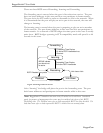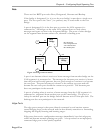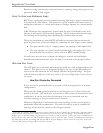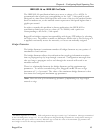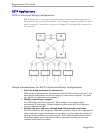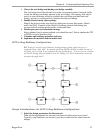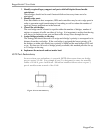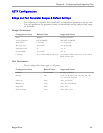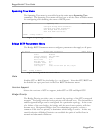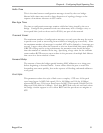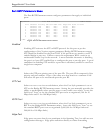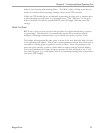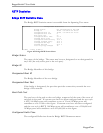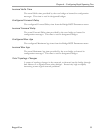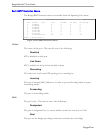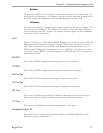
RuggedSwitch™ User Guide
Spanning Tree Menu
The Spanning Tree menu is accessible from the main menu Spanning Tree
command. The Spanning Tree menu will lead you to all the other available menus
for configuring and obtaining the status of RSTP ports.
Figure 37: Spanning Tree Menu
Bridge RSTP Parameters Menu
The Bridge RSTP Parameters menu configures parameters that apply to all ports.
Figure 38: Bridge RSTP Parameters Menu
My Switch Spanning Tree Admin Access
Configure Bridge RSTP Parameters
Configure Port RSTP Parameters
View Bridge RSTP Statistics
View Port RSTP Statistics
<CTRL> Z-Help S-Shell>
My Switch Bridge RSTP Parameters Admin Access
State Enabled
Version Support STP and RSTP
Bridge Priority 32768
Hello Time 2 s
Max Age Time 20 s
Transmit Count 10
Forward Delay 15 s
Cost Style Costs follow STP (16 bit) style
<CTRL> Z-Help S-Shell>
State
Enables STP or RSTP for the bridge (i.e. on all ports). Note that STP/RSTP can
be disabled on a per port basis in the Port RSTP Parameters menu.
Version Support
Selects the versions of STP to support, either STP or STP and Rapid STP.
Bridge Priority
The Bridge Priority provides a way to control the topology of the STP connected
network. The bridge with the lowest priority will become root. The desired Root
and Designated bridges can be configured for a particular topology. In the event
of a failure of the root bridge, the bridge with the next lowest priority will then
become root. Designated bridges that (for redundancy purposes) service a
common LAN also use priority to determine which bridge is active. In this way
careful selection of Bridge Priorities can establish the path of traffic flows in
normal and abnormal conditions.
RuggedCom



